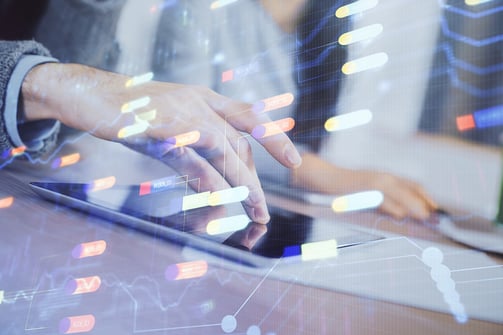Over the past decade, multi touch technology (MTT) has become increasingly popular in a variety of industrial applications. Commonly referred to as “digitizers,” these screens have been found in many industrial equipment, from touchscreens to industrial PCs.
It is used to detect and track multiple touch commands on the surface of a device or monitor object or display screen simultaneously. The ability to detect and track multiple simultaneous touches provides many advantages for industrial users.
The most common use of multi touch technology is to replace traditional mouse click buttons with more intuitive gestures that are easier to learn and operate than mouse clicks.
This article explores the difference between multi touch technology from human machine interface and its benefits in industrial applications.
How Does Multi Touch Technology Differ from Human Machine Interface (HMI)?
While MTT and human machine interface (HMI) are often used interchangeably, the two terms represent very different concepts.
 HMI is the design of systems that enable operators to control or monitor automated equipment. Multi touch technology — which is sometimes referred to as touch technology — is a subset of HMI that involves the use of touch screens and/or touch-pads to control equipment.
HMI is the design of systems that enable operators to control or monitor automated equipment. Multi touch technology — which is sometimes referred to as touch technology — is a subset of HMI that involves the use of touch screens and/or touch-pads to control equipment.
The fundamental differences between these two technologies can be summarized as follows:
- HMI provides operator control over a single piece of equipment. In contrast, multi touch technology is designed to provide operator input into a system composed of several pieces of equipment.
- HMI typically requires the use of a separate pointing device, such as a mouse or joystick. In contrast, MTT uses the same pointing device to perform all functions, including selecting objects, moving objects, scrolling pages, etc.
- HMI usually requires the use of a physical button to initiate actions. In contrast, the multi touch solution allows you to select objects, move objects, scroll pages, etc., simply by touching them.
MTT encompasses the layout and design of displays, input devices, and programs that control machine equipment using gestures and touchscreen technology.
How is MTT Used in Industrial Applications?
Multi touch technology is revolutionizing industrial applications by allowing automation users to interact with digital content in a more natural and intuitive way.
There are many types of touchscreen technology, tool and devices that are being used in a variety of industries, including manufacturing, automotive, aerospace, and healthcare.
By allowing workers to interact directly with digital information using touch screen solutions, this improves this improves productivity by making workflows more efficient.
The Benefits of Using Multi Touch Technology in Industrial Applications
The trend toward multi-touch programs has delivered several benefits for industrial end users.
Users with complex industrial processes—like those in the oil and gas, mining, and power generation industries—can benefit from highly customized and simplified user interfaces activated by multi touch technology.
Deploying multi touch systems to industrial end users will benefit production processes and user experience.
Here are some of its key benefits:
Better level of control and precision
By using multi-touch gestures to manipulate digital content, users can achieve a better level of control and precision that is not possible with traditional HMI input methods, such as a mouse or keyboard.
A touchscreen solution allows users to easily and precisely move, resize, or rotate complex 3D models, which are vital in many industrial applications. For example, multi touch technology allows mold makers to precisely manipulate 3D models of molds, allowing them to fix previously inaccessible details and make critical corrections quickly.
Improved visual efficiency
Using multi touch technology, users can quickly navigate through large amounts of data without having to click on every item individually. This makes it easier and faster for users to find what they need and eliminates the need for multiple clicks.
For example, when working with CAD software, users can zoom in on specific areas of a model and then pan around to view the entire model at once with crystal image clarity when they have industrial touchscreen monitors.
Improved access and collaboration
Using multi touch technology in demanding environments enables teams to work together without being in the same physical space, which can be a big help when working on large-scale projects.
This means they can collaborate remotely, share documents, and discuss ideas over video chat. Such combined experience results in coming up with better solutions faster.
Reduced Costs
 When compared to other technologies, multi touch technology offers significant cost savings:
When compared to other technologies, multi touch technology offers significant cost savings:
- Much easier to install than conventional hardware, meaning that businesses can save on installation costs.
- Requires little maintenance, so businesses don’t have to spend time and money maintaining their equipment.
- Easier to use, making industrial companies’ training costs lower. This allows industrial companies to put more money into core products rather than wasting it on training.
Allow Industrial Parts to Be Test Fit
Part fit is such a crucial issue because parts that don’t fit together properly can cause a wide range of problems. The most common problem is that they may be too tight, causing damage to the machine. However, if the part fits loosely, then there might be issues with alignment, which could lead to other problems down the line.
With touch screen technology, you can test out your part before it goes into production on the factory floor. You can also check whether your part will fit in another machine.
Multi touchscreen Devices in Industrial Applications
Industrial applications have unique requirements that conventional technologies can not meet. Using multi touch systems in industrial applications has been shown to provide industrial environments with key advantages like improved productivity, increased accuracy, and reduced costs.
These systems are becoming more and more prevalent in today’s industry, as newer touchscreen technologies are making their way into everyday settings.
As we continue to develop our understanding about how to integrate multi touch technology with other technologies, we expect greater adoption of the touch screen solutions in many business environments.
To learn how Radwell International can support your manufacturing operation

